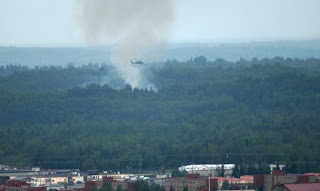A new
aircraft programme for Pakistan has brought benefits not only to the air
force but to its aerospace industry. Air Commodore Azfar A Khan (retd)
describes how and why the aircraft that marks a milestone in the
aviation history of Pakistan was developed.
When the time came to replace its large, obsolete
fleet with modern, lightweight, multi-role combat aircraft, the Pakistan
Air Force (PAF) opted for a low-cost solution and not pricier Western
designs. The result was an aircraft that could be manufactured in
Pakistan in collaboration with the People's Republic of China - the
lightweight fighter bomber JF-17 Thunder.
Developed by the Pakistan Aeronautical Complex and Chengdu Aircraft
Industry, China, production is being undertaken at Pakistan Aeronautical
Complex, Kamra.
The PAF officially inducted its first JF-17 squadron on 18 February
this year. Initially, about 10 to12 squadrons are to be produced, but
the PAF will ultimately acquire up to 250 pieces. From 2011, 15-16
aircraft will be produced annually, which may eventually be increased to
25 per year.
It is hoped the JF-17 will provide a low-cost replacement for a
number of developing countries currently operating ageing MiG-21/F-7 and
F-5 aircraft, such as Azerbaijan, Algeria, Sudan, Zimbabwe, Bangladesh,
Egypt, Iran, Lebanon, Malaysia, Morocco, Myanmar, Sri Lanka and
Nigeria. Some of these nations have already confirmed orders.
Specification
The JF-17 is powered by a single Russian RD-93 turbofan engine, a
widely used model known to be reliable. The turbofan design gives more
thrust and significantly lower specific fuel consumption than a turbojet
engine. The engine has gained attention for its acceleration and quick
response, with test pilots describing reactions as "virtually
instantaneous". Using a single engine also significantly reduces both
maintenance time and cost.
"Initially, about 10 to12 squadrons are to be produced, but the PAF will ultimately acquire up to 250 pieces."
The aircraft can be armed with up to 3,629kg (8,000lb) of air-to-air
and air-to-ground ordnance along with other equipment mounted externally
on the aircraft. The glass cockpit, meanwhile, incorporates an
electronic flight instrument system (EFIS) and a wide-angle head-up
display (HUD), and it has a minimum total field of view of 25 degrees.
The EFIS provides basic flight information, as well as tactical, engine,
fuel, electrical, hydraulics, flight control and environment control
systems information. The HUD and multi-function display (MFD) are
'smart' (meaning they can be configured by the pilot to show any of the
available information), the avionics system is all-digital and fully
integrated, and the solid state avionics is of a modular design.
Several radars were tested onboard prototypes of the JF-17, including
Israel's Elta EL/M-2032, Russia's Phazotron Super Komar, Italy's FIAR
Grifo-S7, Brittain's GEC-Marconi Blue Hawk and France's Thomson-CSF
RC-400. However, a Chinese radar was selected for the first batch of
craft, although Italy and France are in the running for future
contracts, according to reports.
The software written for the avionics comprises more than one million
lines of instructions, making use of the concept of open architecture.
This software is written using the popular civilian C++ programming
language, rather than a military language such as Ada, to better utilise
the large number of civilian software programmers available in the
market.
Building
The production of JF-17 parts and components begun as far back as
2005 and manufacture of its sub-assemblies started in 2008. The
production of major assemblies is undertaken by Pakistan's large public
sector units (PSUs), while parts and components are provided by
private-sector suppliers.
Pakistan has a highly skilled and trained technical workforce - a
prerequisite for the manufacture of an indigenous aircraft - that can be
cheaper to employ when compared with other areas around the world. For
example, some of the workforce deployed for the production of the JF-17
are retired personnel from the Pakistan Air Force. This manpower is
available at a rate of $10 per hour whereas the international market can
charge up to $45 per hour.
"The total cost of the JF-17 programme is US$500m."
It is this cost-effectiveness that led the PAF to take on the task of
making its own aircraft. The unit production cost of a JF-17 translates
into approximately US$15 million apiece whereas a multi-role aircraft
in the international market is available for US$50m a piece. Overall,
the total cost of the JF-17 programme is US$500m, divided equally
between China and Pakistan.
Furthermore, Pakistan will earn a good exchange rate through the sale
of this aircraft and its associated spares to other countries, keep its
retired aircraft workers employed, and provide the country's internal
market with new opportunities to build technologies and develop new
innovations.
Main A JF-17 on display at the IDEAS 2008 defence exhibition in Karachi, Pakistan.




